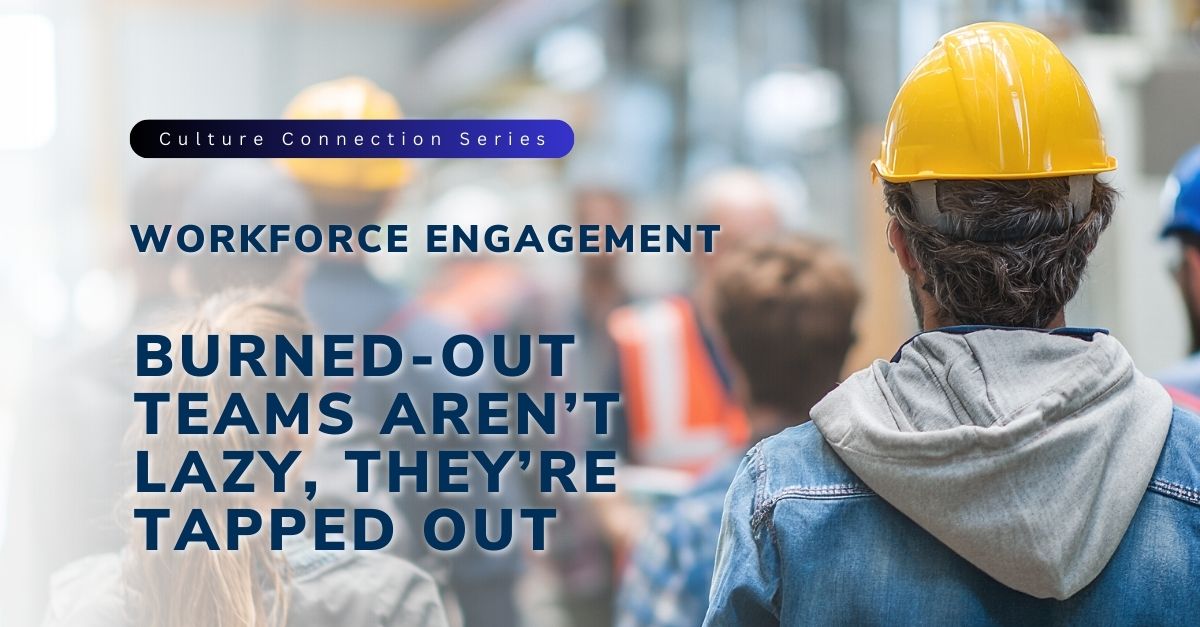
How chronic overtime, unclear priorities, and lack of autonomy crush engagement, and what supervisors can do instead.
When a team’s energy drops, it’s easy to assume they’re not motivated. But in most manufacturing plants, “low effort” is rarely about laziness. More often, it’s the result of being stretched too thin for too long.
And unlike a temporary slowdown, burnout doesn’t fix itself. Without changes in how work is managed, performance continues to slip no matter how much pressure you apply.
The good news? Supervisors have a lot of control over the conditions that lead to burnout. By spotting the early signs and making targeted changes, you can stop it before it drains your team completely.
What’s Really Draining Your Team
Chronic Overtime
When every week feels like “peak season,” people don’t get time to recover. Extra hours become the norm instead of the exception. That means fatigue sets in faster, attention to detail slips, and even small equipment issues feel overwhelming. Over time, productivity drops, not because people don’t care, but because their energy tanks are empty.
Unclear Priorities
If the target keeps moving, it’s hard for teams to hit it. Constantly shifting direction mid-shift, or failing to set clear priorities at all, creates confusion and frustration. Crews end up doing work that later has to be redone or abandoned. Without a clear, stable focus, even high performers start disengaging.
Lack of Autonomy
When every decision has to be approved by a supervisor, it bottlenecks problem-solving. Skilled team members lose the motivation to take initiative if they’re never trusted to act. Instead of tackling small problems in real time, they wait for instructions, which slows production and leaves issues to pile up.
Poor Communication
Important information doesn’t always make it to the people who need it, especially during shift changes or when multiple departments are involved. Without a reliable way to pass along updates, teams spend too much time chasing down answers instead of producing. That constant back-and-forth creates frustration and makes people feel disconnected from the bigger picture.
Inconsistent Leadership
When different supervisors enforce different rules or fail to follow through on commitments, it erodes trust and buy-in fast. Workers start focusing on “who’s in charge today” instead of focusing on the job. Over time, this inconsistency makes employees feel like it’s not worth giving their best effort, because the standard is always changing.
How to Stop Burnout Before It Starts
1Set and Stick to Clear Priorities
Start each shift with a short huddle to lay out the top three goals for the day. Keep those goals visible on a whiteboard or dashboard so there’s no confusion. Avoid mid-shift changes unless they’re absolutely necessary, and if you do need to make a change, explain why.
2Give Autonomy Where It Makes Sense
If a team member is trained and capable, let them make decisions on the spot for the tasks they own. This not only speeds up production but also builds a sense of ownership. Recognize and reinforce good judgment when you see it, it encourages more of the same.
3Balance the Workload
Spread the hardest jobs around instead of letting the same people shoulder them every day. Rotate tasks so skills stay sharp across the team. Limit overtime to situations that truly require it, and plan ahead to cover peak demand without exhausting your crew.
4Keep Communication Tight
Use a consistent process for shift handoffs, written notes, a digital log, or a quick in-person overlap if possible. Make sure updates on priorities, issues, and changes reach everyone, not just a few. Don’t assume the message got through, confirm it with the team.
5Lead with Consistency
Be fair, be steady, and do what you say you’re going to do. Apply rules the same way every day, regardless of who’s on the shift. When teams know what to expect from you, they can focus on the work instead of second-guessing what’s coming next.
Bottom Line
Burnout isn’t about laziness, it’s a workplace condition caused by the way work is managed. Supervisors who protect their team’s time, clarify the target, and lead with consistency see higher engagement, fewer mistakes, and stronger results. Addressing burnout isn’t just about making people feel better, it’s about keeping production moving at the right pace without burning through your most valuable resource: your people.
How POWERS Can Help
POWERS is a management consulting firm that works with manufacturing leaders to build engagement directly into daily operations, not as an “extra task,” but as part of how work gets done every shift.
DPS, our Digital Production System gives supervisors real-time visibility into workloads, performance, and potential problem areas. This allows them to make smart, timely decisions, balance workloads before fatigue sets in, and address small issues before they grow into bigger problems. DPS also helps standardize communication and performance tracking so leadership stays consistent across shifts and departments.
By combining on-the-floor coaching, proven management consulting practices, and the right digital tools, we help manufacturers create a work environment where employees stay engaged, productivity stays steady, and turnover drops. The result: stronger teams, higher output, fewer errors, and a healthier bottom line.
- Speak to an Expert: Call +1 678-971-4711 to discuss your specific challenges and goals.
- Email Us: Get tailored insights by emailing info@thepowerscompany.com
- Request an Assessment: Use our online contact form, and one of our expert manufacturing consultants will reach out to schedule an in-depth analysis of your operations.

